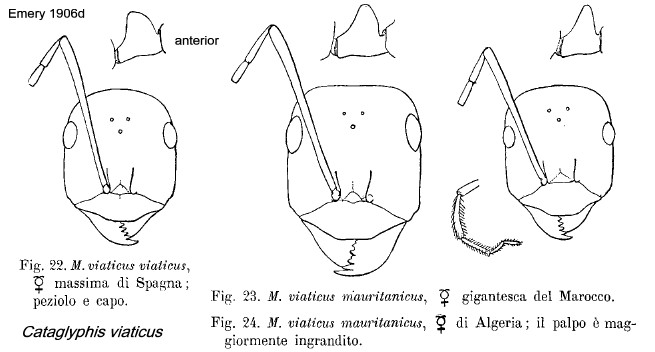Cataglyphis viaticus (Fabricius)
  Bolton (1995) had - Type
location Spain (Formica viatica, Fabricius, 1787: 308,
worker; Mayr, 1861, queen & male) - no images on Antweb (July 2014) Bolton (1995) had - Type
location Spain (Formica viatica, Fabricius, 1787: 308,
worker; Mayr, 1861, queen & male) - no images on Antweb (July 2014)
junior synonyms
europaea
(Formica cephalotes ssp europaea,
Christ, 1791: 511, illustrated, worker; synonymy Emery, 1892b: 161)
from "Europe" - no images on Antweb (July 2014)
bugnioni
(Myrmecocystus viaticus F. r. adenensis Forel v. Bugnioni n. var., Forel, 1908a: 16;
Santschi, 1929b: 41, worker) from Egypt, Suez - new
placement here - see below.
all forms known.
Fabricius' (1787) description is at -  . Christ's (1791) description of europaea
is at - . Christ's (1791) description of europaea
is at -  . Olivier (1792) had the description - . Olivier (1792) had the description -  . Mayr (1855: 381) had the description (as Monocombus
viaticus) - . Mayr (1855: 381) had the description (as Monocombus
viaticus) -  . Emery (1906b) had the
description - . Emery (1906b) had the
description -  . Forel's (1908a)
description of bugnioni
is at . Forel's (1908a)
description of bugnioni
is at  . .
Note from the description and illustration it is clear
that
the form listed in Bolton (1995: 137) as subspecies tonsilis
(Cataglyphis (Monocombus) viatica
F. st. mauritanica Em. v. tonsilis n. var., Santschi, 1929b:
32; Cataglyphis (Monocombus) viaticus
For. v. tonsilis Sants.,
Santschi, 1936a: 209, all forms) from Morocco, is a subspecies
or junior synonym of Cataglyphis mauritanicus.
|
 Fabricius
stated specimens from the Iberian Peninsula
were ferruginous with a black gaster. Mayr (1855) appears to have
confused the identities as he gave the colour as blood red with a dark
gaster. He listed it as found across much of southern Europe and gave Formica
megalocola Foerster as a synonym. F. megalocola now is
recognised as a junior synonym of Cataglyphis
bicolor. Fabricius
stated specimens from the Iberian Peninsula
were ferruginous with a black gaster. Mayr (1855) appears to have
confused the identities as he gave the colour as blood red with a dark
gaster. He listed it as found across much of southern Europe and gave Formica
megalocola Foerster as a synonym. F. megalocola now is
recognised as a junior synonym of Cataglyphis
bicolor.
Christ, J. L. 1791. Naturgeschichte, Classification und
Nomenklatur der Insecten von Bienen, Wespen, und Ameisengeschlecht; als
der fuenften Klass fuenften Ordnung des Linneischen Natur-Systems von
den Insecten Hymenoptera. Hermann, Frankfurt am Main. 535 pp
One of the species studied by Dahbi, Hefetz & Lenoir
(2008) - http://irbi.univ-tours.fr//UIEIS/Publis%20AL/Dahbi2008-BSE.pdf
|
 Agosti (1990a),
however, separated tonsilis as a
variety of mauritanicus in the altisquamis-group (see
above). Some clarification comes from
Wehner, Wehner & Agosti (1994), who provided the illustration
(right). Agosti (1990a),
however, separated tonsilis as a
variety of mauritanicus in the altisquamis-group (see
above). Some clarification comes from
Wehner, Wehner & Agosti (1994), who provided the illustration
(right).
I have separated off Cataglyphis
desertorum, which appears to be clearly distinct, with a
nodiform petiole, and not least from the geographical separation. Thus,
the true distribution of viaticus appears to be western North
Africa and the Iberian Peninsula
|